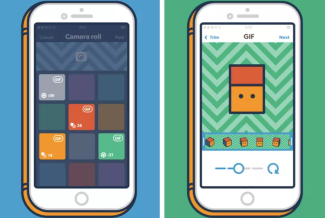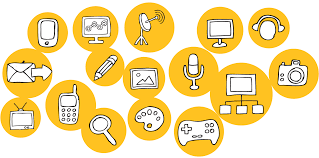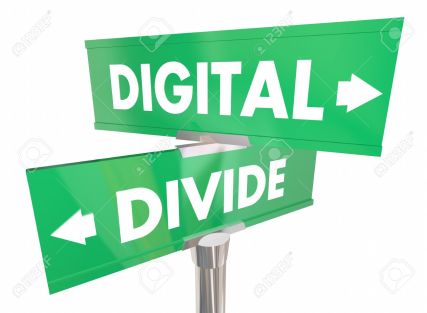Digital convergence… What it really is
Digital convergence is a process which technological devices work together with each other to create one device. In other words; digital convergence is a process in which merges two or more functions of a device into one device.
Having digital convergence in society it allows and expands the variety and availability of tools to access the basic functions of the Internet. (Serrano-Santoyo, Cabrera-Flores, 2014, p.29-31)
An example of a digital convergent device is a smartphone. A smartphone is portrayed in the video as a digital converging technology as it is one device that can do multiple tasks a PC or laptop can do. Such as reading emails, stream videos on Youtube, access social media websites such as Facebook, Twitter, Instagram, watch movies etc;

How can digital convergence be used in a classroom/school?
Digital convergence allows the easy access to the Internet, which supports and increases the possibilities for interaction and collaboration between students/classmates. However, some researchers have stated that depending on digital interaction may decrease other human interaction. Meaning students and children will depend solely on technology and forget how to communicate and learn in ways which do not involve a technological device. (Serrano-Santoyo, Cabrera-Flores, 2014, p.29-31)
Using digital convergence devices in an educational environment it is so much more than just the use of ICT devices every-day. Having digital convergence has become an important factor in settings where teamwork is possible such as a classroom with factors of culture, social aspects, ethical background and the economy. (Serrano-Santoyo, Cabrera-Flores, 2014, p.29-31) As teachers, we need to incorporate more interactive activities using digital convergent devices to help students get a better sense of collaboration.
A way of digital convergence being used in a classroom is being shown in this video. The video is a great example of how a digital convergent device such as an iPad can be used in the classroom such as presenting a powerpoint and how it can be used as a collaborative device.
References:
Santoyo- Serrano, Caberera-Flores, R., Mayer, (2014). Channeling Digital Convergence in Education for Societal Benefit. https://ieeexplore-ieee-org.dbgw.lis.curtin.edu.au/document/6969190/
Donna, Miss. (Producer). (2015, April 18). Digital Convergence- example of a mobile phone. [Streaming Video]. Retrieved from https://www.youtube.com/watch?v=o9hq50FoH5o
Roepke, Jon. (Producer). (2014, July 7). Turn your iPad into an Interactive Digital Creation and Presenting Tool. [Streaming Video]. Retrieved from https://www.youtube.com/watch?v=acOrLXK2kW0
Transmedia Storytelling Used in Education
Ever wondered how Transmedia is used in an educational way? That is easy, just click on the link here to find out!
(Below is the script for you to follow on!)
Hi, my name is Allan and today we are going to be talking about Transmedia. Transmedia storytelling is a process which uses multiple media platforms to narrate a story. Transmedia storytelling is fully participatory, meaning the reader and audience are very involved. In that case, the reader is the teacher and the audience is the student or students. (Rutledge,2018) There are two types of transmedia they are: Experience or closed and framework or known as open. Experience transmedia is an individual or group uses multiple platforms to create an experience which they can all enjoy and learn from. Experience transmedia is commonly known as a franchise and is typically used for marketing purposes such as advertisements. Meaning, a company creating a branding component across various amounts of media platforms to create a message which everyone can understand. This allows the network culture to interact socially with people allowing opportunities to explore, interpret and expand. On the other hand, using framework transmedia for education includes student involvement. Using transmedia in education, there are a few aspects you need to consider. Such as: which platform would be best for students needs and learning styles, engage learners, by that it means if the students are more engaged in the narrative, the closer they will feel to the content and hopefully adapt their learning in real life settings. According to Henry Jenkins, students should have as a minimum the ability to search and distribute information on multiple platforms, to analyse and manage multiple streams of different information, the ability to represent and have ideas using a combination of images and text to make effective use from reading things on media platform such as a screen on a phone. Overall, teaching with transmedia needs an instructor such as a teacher to understand that reading on a computer or mobile phone is different than reading from a book because readers do not get the same experience and they start to lose interest faster due to distractions around them. (Pence, 2012)
References:
Pence, E., Harry. (2012). Teaching with Transmedia. Retrieved from: http://journals.sagepub.com.dbgw.lis.curtin.edu.au/doi/abs/10.2190/ET.40.2.d
Rutledge, P. (2018). Transmedia Storytelling. Brands, Ideas, Organisations and Advocacy.
Retrieved from: http://athinklab.com/transmedia-storytelling/what-is-transmedia-storytelling/
The Digital Divide Which Affects the Way Students Learn

Learn about the digital divide and how it can affect education “here.”